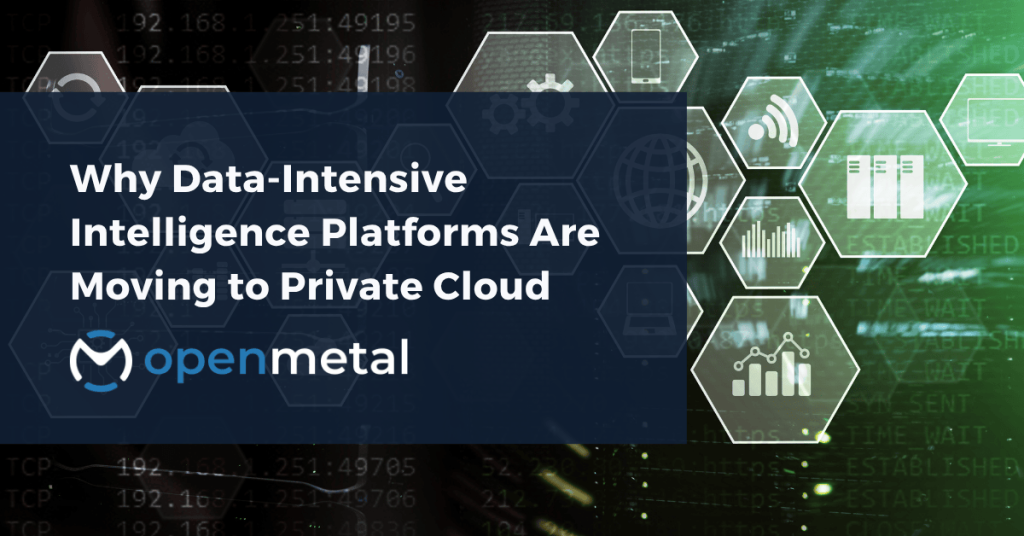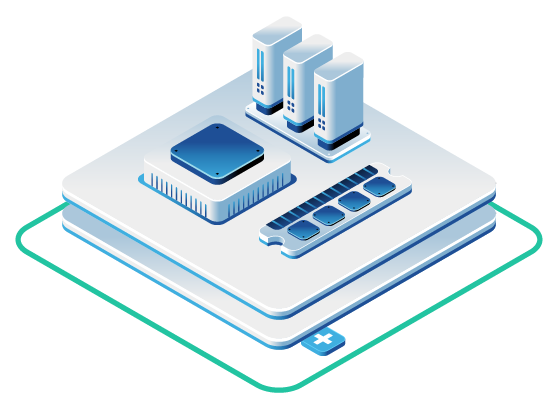
Ready to move past unpredictable public cloud economics?
The OpenMetal team is standing by to assist you with scoping out a fixed-cost model based infrastructure plan to fit your team’s requirements, budgets, and timelines.
Key Takeaways
- Data-intensive intelligence platforms face mounting cost volatility in hyperscale environments, with unpredictable egress fees and API charges disrupting financial planning
- OpenMetal Private Cloud provides dedicated OpenStack-based infrastructure with extensible Ceph storage, restoring performance consistency without sacrificing scalability
- Organizations managing continuous data ingestion, ETL pipelines, and ML workloads benefit from fixed-resource pricing that eliminates billing unpredictability
- OpenMetal’s XL v4 hardware delivers high-throughput compute paired with unified object, block, and file storage that scales horizontally without downtime
- The shift toward private cloud infrastructure reflects industry-wide demand for visible, controllable infrastructure that supports compliance requirements and sovereignty needs
Data-intensive intelligence platforms have become the infrastructure backbone for organizations making sense of massive, continuously expanding datasets. Whether you’re building trade analytics engines, ESG risk platforms, or financial forecasting systems, your infrastructure choices now directly shape product velocity and competitive positioning.
Here’s what’s changed: the economics and control models of hyperscale public clouds no longer align with how these platforms operate. When your data flows non-stop and every query touches terabytes, unpredictable pricing becomes an operational hazard. Performance inconsistency undermines confidence. Compliance pressures demand sovereignty that public cloud abstractions can’t deliver.
This isn’t about abandoning cloud computing—it’s about reclaiming what made cloud attractive in the first place. OpenMetal’s Private Cloud, built on OpenStack with extensible Ceph storage, represent the next evolution: self-service infrastructure with the control, transparency, and predictability that data-intelligence platforms require.
The Data Gravity Problem: When Immobility Meets Volatility
Your data isn’t just large—it’s locked in place. Once you’ve accumulated petabytes of historical records, real-time feeds, and processed results, moving that data becomes technically impractical and financially prohibitive. This phenomenon, known as data gravity, anchors your entire operation to specific infrastructure.
In hyperscale environments, this creates a compounding problem. Storage costs fluctuate based on access patterns you can’t always predict. Egress fees pile up when analytics workloads pull data across regions or availability zones. API calls—thousands per second for continuous ingestion pipelines—add unpredictable line items to monthly bills.
Organizations managing complex data operations report significant challenges with cloud cost forecasting and management. Industry research from the FinOps Foundation shows that reducing waste and managing commitment-based discounts became top priorities in 2024, overtaking other operational concerns for the first time since their annual survey began. The shift reflects mounting economic pressure across organizations dependent on cloud infrastructure.
When you’re running continuous ingestion, transformation, and model training, every operational decision becomes a cost center. Your team can’t plan confidently when next month’s bill depends on usage patterns three layers deep in your stack. Infrastructure teams find themselves constantly reacting to cost anomalies rather than building.
Regaining Control: What Makes a OpenMetal Private Cloud Different
OpenMetal’s Private Cloud isn’t traditional on-premises infrastructure dressed up with new terminology. It’s a fully functional cloud environment—API-driven, self-service, programmable—that you own and operate.
OpenMetal’s implementation demonstrates what this model delivers. Built on OpenStack, the platform provides the same programmatic control as any public cloud: instant VM provisioning, network segmentation, storage orchestration. Root-level access means your team can optimize at every layer without negotiating with vendor support.
Market momentum supports this architectural shift. Recent data indicates dedicated cloud infrastructure spending grew substantially in 2024, with projections showing continued expansion through 2028. This growth reflects organizations recognizing that certain workloads require infrastructure models beyond shared public cloud environments.
The distinction matters for compliance-driven organizations. When regulations mandate data residency or require audit trails showing exactly where data lives and who accessed it, abstracted public cloud models create friction. A Private Cloud places that control directly in your hands, making compliance documentation straightforward rather than speculative.
The Architecture That Powers Data Intelligence at Scale
Compute Foundation
As an example, OpenMetal’s XL v4 hardware provides the computational foundation for data-intensive workloads. Each node features dual Intel Xeon Silver 4510 or 6530 CPUs, substantial memory capacity, and high-speed NVMe storage. This configuration supports the sustained throughput that ETL pipelines and machine learning training demand.
Full root control means you can tune kernel parameters, install custom drivers, and configure networking at the lowest levels. OpenStack APIs let you create isolated environments for different workload types—ingestion clusters separate from analytics infrastructure, training environments isolated from production inference.
Extensible Storage: Unified Architecture That Scales Horizontally
Ceph provides unified object, block, and file storage under a single architecture. This matters for data-intelligence platforms because your storage needs aren’t homogeneous. Hot data—recent transactions, active model weights—requires NVMe performance. Archival data and compliance retention can sit on less expensive HDD-based pools.
The system scales horizontally without downtime. As datasets grow, you add storage nodes that integrate seamlessly into existing pools. S3-compatible interfaces mean existing data pipelines continue working without modification. Block storage supports databases and stateful applications. File storage handles shared datasets across compute clusters.
Networking Designed for Predictability
OpenMetal’s networking architecture eliminates one of public cloud’s biggest pain points: unpredictable data transfer costs. 20Gbps (dual 10Gbps) private links connect nodes for east-west traffic. VXLAN segmentation provides secure multi-tenant isolation when needed.
The key difference is fixed-port egress pricing. You pay for committed bandwidth, not per-gigabyte transfers. This transforms cost planning from reactive guesswork into straightforward capacity management. Dedicated VLANs support hybrid architectures or regulated workload isolation without introducing variable billing.
Business Impact: From Hidden Costs to Strategic Assets
Financial Predictability Transforms Planning
Fixed-resource pricing changes how finance teams approach infrastructure budgets. Instead of forecasting usage patterns and hoping cost models hold, you commit to known capacity at known prices. Quarterly planning becomes reliable. FinOps teams can shift from constant firefighting to strategic optimization.
Operational Confidence Enables Innovation
When your team knows exactly what infrastructure will cost and how it will perform, they can plan bigger projects. No one hesitates to spin up development environments or run experimental analytics workloads. Noisy neighbor problems disappear—your workloads run on your hardware, period.
Compliance Becomes Implementation, Not Negotiation
Data residency requirements stop being conversations with cloud vendor legal teams and become architecture decisions. GDPR, PDPA, and sector-specific regulations all require knowing exactly where data resides and how it moves. With a Private Cloud with OpenMetal, you design those patterns directly.
The Intelligence Cloud Pattern: Common Architecture Across Verticals
Data-intelligence platforms share structural similarities regardless of vertical. You’re continuously ingesting data from multiple sources. You’re correlating that data against historical baselines and external references. You’re running analytics to extract signals. You’re training and serving machine learning models.
This operational pattern demands infrastructure that can handle sustained throughput without performance degradation. It requires storage that accommodates rapid dataset expansion without service disruption. It needs networking that supports high-volume internal data movement without variable costs.
Organizations building these platforms increasingly recognize that infrastructure transparency becomes competitive differentiation. When you understand exactly how your stack performs and what it costs, you can make smarter product decisions about feature development and market expansion.
Industry Trajectory: From Convenience to Sovereignty
The shift toward private cloud infrastructure reflects broader market evolution. Industry analysis shows rising organizational adoption of hybrid cloud approaches that balance public cloud flexibility with private infrastructure control. This isn’t repatriation in the traditional sense—it’s architectural maturation.
Research into OpenStack adoption reveals substantial growth driven by multiple factors. Organizations seeking alternatives to proprietary virtualization platforms have turned to open-source infrastructure. Companies building AI and machine learning capabilities require infrastructure optimized for specialized hardware and high-performance workloads. Digital sovereignty concerns push enterprises toward locally controlled infrastructure resources.
The FinOps movement itself signals this evolution. As organizations gained experience with variable cloud costs, they developed sophisticated practices for managing that complexity. But management overhead has its own costs. For workloads with predictable capacity needs and continuous operation, fixed-cost infrastructure often provides better total economics.
The Path Forward: Visible Infrastructure as Strategic Imperative
Infrastructure decisions now directly impact every layer of data-intelligence platform operations. Performance affects product capabilities. Cost structure influences pricing strategy. Sovereignty determines market access.
Organizations building the next generation of intelligence platforms increasingly recognize that infrastructure shouldn’t be treated as a hidden utility layer. It’s a strategic component that deserves transparency, understanding, and intentional control.
OpenMetal’s Private Cloud represent this philosophical shift made concrete. They deliver public cloud’s operational benefits—programmability, self-service, API-driven automation—while restoring the visibility and predictability that data-intensive operations require.
For platforms processing sensitive data at scale, running continuous analytics pipelines, or training machine learning models on proprietary datasets, this architectural model isn’t a step backward. It’s the logical evolution of cloud computing for workloads where control, transparency, and predictability matter as much as flexibility.
The question isn’t whether to use cloud computing. The question is which cloud model serves your specific operational requirements. For data-intelligence platforms, the answer increasingly involves infrastructure you can see, understand, and control completely.
OpenMetal’s Private Cloud delivers OpenStack infrastructure with extensible Ceph storage on high-performance hardware. If you’re building data-intensive platforms and ready to move past unpredictable public cloud economics, let’s talk about what visible infrastructure can do for your operations.
FAQ
Q: How does OpenMetal’s Private Cloud differ from traditional colocation or managed hosting?
OpenMetal Private Cloud provides a complete cloud platform with self-service APIs, automated provisioning, and programmable infrastructure—capabilities you’d find in public clouds. Traditional colocation gives you physical space and network connectivity, but you build everything else yourself. A Private Cloud Core (PCC) on OpenMetal delivers ready-to-use OpenStack with Ceph storage, networking, and orchestration already configured and maintained.
Q: Can I integrate OpenMetal Private Cloud with existing public cloud resources?
Yes, hybrid architectures are common. Organizations often use OpenMetal’s Private Cloud for core data-intensive workloads requiring predictable performance and costs, while leveraging public cloud for burst capacity, specific managed services, or geographic distribution. OpenMetal’s networking architecture supports dedicated VLANs and VPN connectivity for secure hybrid deployments.
Q: What level of operational expertise do I need to manage OpenStack infrastructure?
OpenMetal provides managed OpenStack infrastructure, handling platform updates, security patches, and core system maintenance. Your team focuses on deploying workloads and managing application-level concerns rather than administering the cloud platform itself. This managed approach reduces the operational complexity typically associated with running private OpenStack deployments.
Q: How does pricing compare to hyperscale cloud for sustained, high-throughput workloads?
For workloads with predictable capacity needs and continuous operation—like data ingestion pipelines, analytics clusters, or ML training infrastructure—fixed-resource pricing typically provides better economics than variable consumption-based models. You’re paying for committed capacity rather than metered usage, which eliminates cost spikes from data transfer, API calls, and storage access patterns.
Q: What happens when my data storage or compute needs exceed current capacity?
The architecture scales horizontally. You can add compute nodes or expand Ceph storage clusters without downtime or service disruption. Because the system is built on open-source foundations (OpenStack and Ceph), scaling follows well-established operational patterns rather than vendor-specific limitations.
Read More Blog Posts
Works Cited
- “Cloud Infrastructure Spending Continued in Accelerated Mode in the Fourth Quarter of 2024 as AI Investment Path Surpasses the Most Positive Expectations.” International Data Corporation, 27 Mar. 2025, my.idc.com/getdoc.jsp?containerId=prUS53284225. Accessed 8 Oct. 2025.
- “OpenStack Deployments Grow as OpenInfra Community Marks 15 Years, Flamingo Release.” PR Newswire, Oct. 2025, www.prnewswire.com/news-releases/openstack-deployments-grow-as-openinfra-community-marks-15-years-flamingo-release-302572632.html. Accessed 8 Oct. 2025.
- “Reducing Waste and Managing Commitments Top Key Priorities for FinOps Practitioners.” FinOps Foundation, 2024, www.finops.org/insights/key-priorities-shift-in-2024/. Accessed 8 Oct. 2025.


































